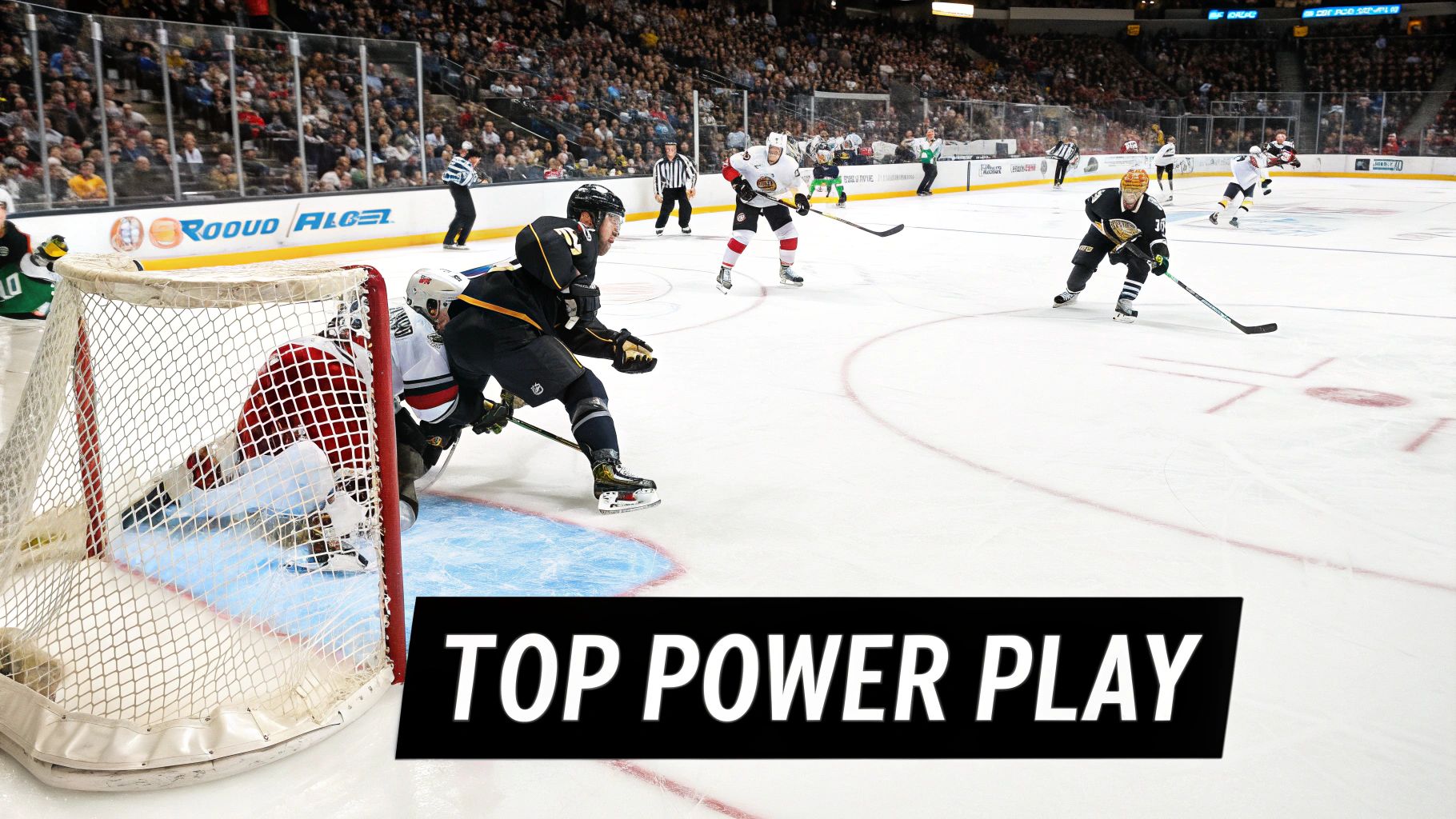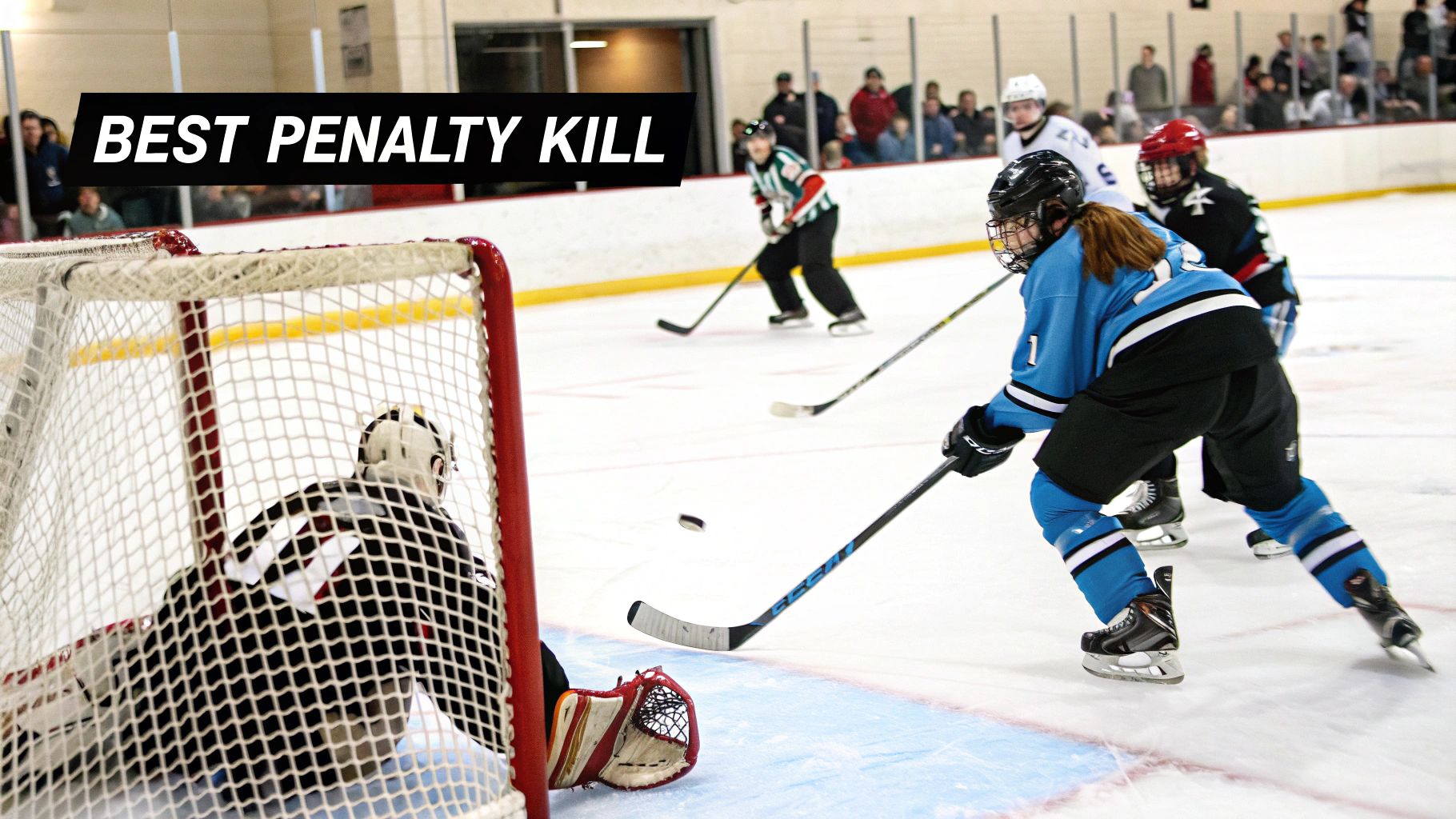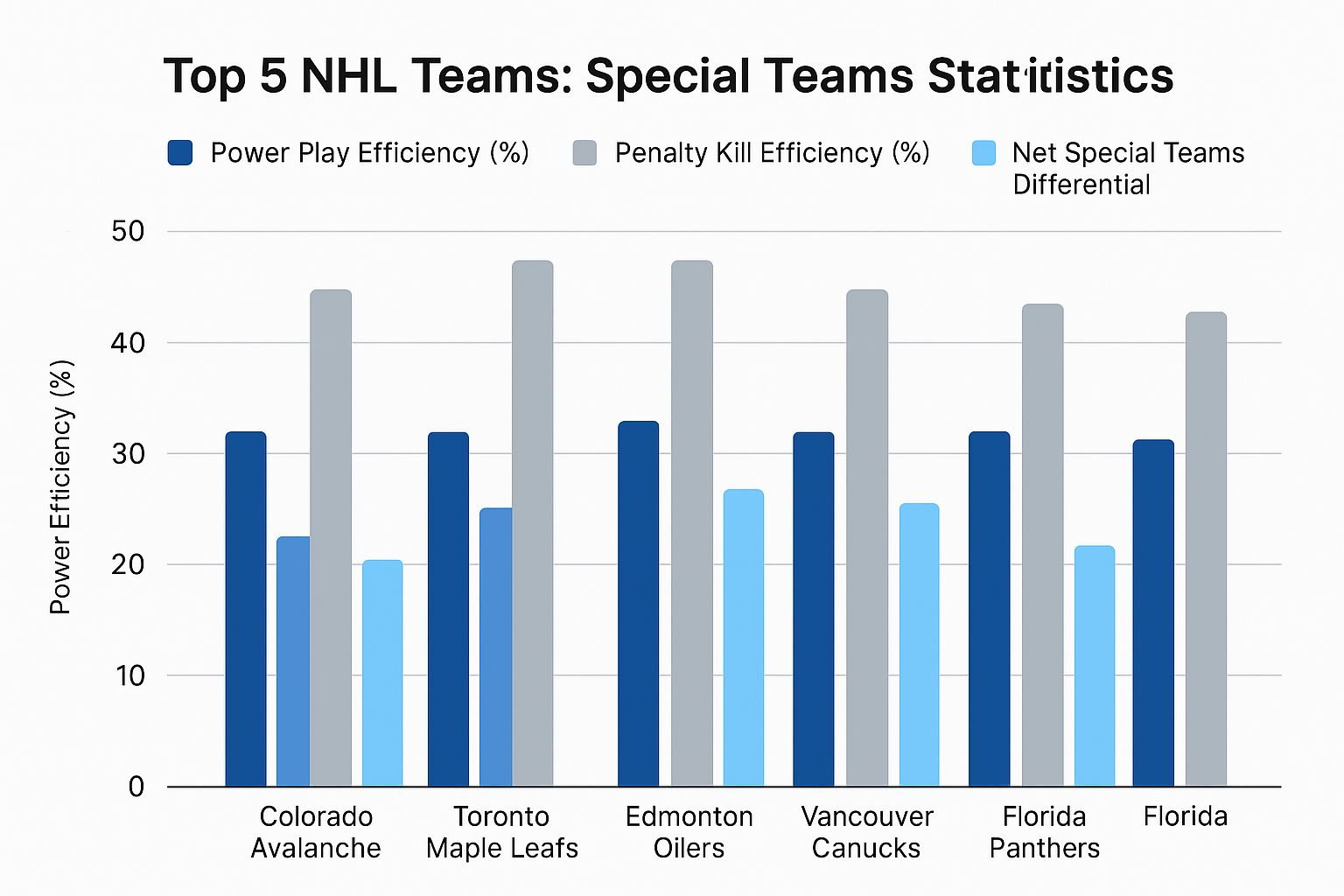NHL Special Teams Rankings A Complete Guide

When it comes to winning hockey games, five-on-five play gets most of the attention. But it's the moments when the game breaks down—a hooking call, a trip, a high stick—that often decide the outcome. This is the world of special teams.
The quickest way to gauge a team's special teams prowess is by combining their power play percentage (PP%) and their penalty kill percentage (PK%). Add them together, and you get a single number that tells a big story. Anything over 100 is the mark of a truly effective, well-coached unit.
Deconstructing Special Teams Performance Metrics
In hockey, penalties create high-stakes scenarios. One team suddenly has a numbers advantage (the power play), while the other is forced to defend shorthanded (the penalty kill). How a team performs in these crucial minutes can make or break their season, which is why a deep dive into the NHL special teams rankings is so essential.
Two units are at the heart of it all, each with a clear job and a simple way to measure success.
- Power Play (PP): This is your offensive unit. When an opponent takes a penalty, these are the players sent out to capitalize on the advantage and score.
- Penalty Kill (PK): This is your defensive backbone. When a teammate is in the box, this group's only job is to shut down the other team's power play and prevent a goal.
Calculating Efficiency
Tracking how well these units perform is straightforward. A team's power play percentage is just the number of power play goals they score divided by the total number of opportunities they get. A higher number means a more lethal advantage.
On the flip side, penalty kill percentage is calculated by dividing the number of successful kills (no goal allowed) by the total times a team was shorthanded. A high PK% points to a tough, disciplined defensive squad that can weather the storm.
The Combined Special Teams Index
To see the complete picture, analysts add these two percentages together. A total of 100 (say, a 20% PP and an 80% PK) is generally considered the league average. Anything north of that number suggests a team is consistently winning the special teams battle.
Take a team like the Toronto Maple Leafs, who hovered around a deadly 25.5% on their power play during the 2023-24 season. That kind of efficiency provides a massive edge night in and night out. You can find the full stats for every team on the official NHL site. This combined index is more than just a number; it's a powerful indicator of a team's coaching, discipline, and strategic depth.
How We Rank Special Teams

To build a truly useful set of NHL special teams rankings, you have to dig deeper than the basic percentages. Power Play Percentage (PP%) and Penalty Kill Percentage (PK%) are the foundation, sure, but they don't tell the whole story. Our method blends old-school numbers with modern analytics to give you a clearer picture of what’s really going on.
We start with the official data from the NHL—the core PP% and PK% stats. But we don't stop there. Think about it: a team could have a sky-high PP% by getting a few lucky bounces, even if they aren't generating many quality chances. That kind of success usually doesn't last.
Going Beyond the Basics
To sort the lucky from the legitimately good, we bring in a few key advanced metrics. These stats help measure the quality of chances a team creates or gives up, which is a much better predictor of future performance.
- Expected Goals For per 60 (xGF/60): This one’s for the power play. It looks at shot quality to see if a team is consistently creating dangerous scoring opportunities. A high xGF/60 is a great sign, even if the puck isn't always going in.
- Expected Goals Against per 60 (xGA/60): This is the flip side for the penalty kill. A low xGA/60 means a PK unit is doing an excellent job of preventing high-quality shots from the other team.
If you want to get a better handle on some of these modern hockey stats, check out our guide that explains what Corsi is in hockey and how it helps measure puck possession.
Factoring in Game-Changing Plays
Finally, our model gives weight to those massive momentum-swinging moments: shorthanded goals. A team that scores while down a man has an aggressive, game-breaking penalty kill. On the other hand, giving one up is a gut punch.
For example, a team with a 21% power play that also gives up five shorthanded goals will rank lower than a team with a 20% power play that allows zero. It's all about the net impact.
By blending the traditional stats with smarter analytics and crucial situational plays, we get a much more honest and nuanced ranking of where every team’s special teams unit truly stands.
Elite Tier Special Teams: The Top Contenders

Some teams just consistently win the special teams battle. It's what separates the good from the great. These elite units don't just get by; they dominate, often putting games out of reach before the third period even starts. Their success isn't luck—it's the product of raw talent, smart coaching, and near-perfect execution.
These are the teams you'll always find at the top of the NHL special teams rankings. Their power plays are clinical, and their penalty kills are downright suffocating. Let's break down the squads who have mastered these game-changing situations.
The Power Play Powerhouses
A deadly power play always starts with a "quarterback," usually a top-tier offensive defenceman who dictates the pace and moves the puck from the blue line. Most of these units run a 1-3-1 formation, a setup designed to create multiple shooting and passing lanes at once, making them a nightmare to defend against.
Just look at a team like the Edmonton Oilers historically. With two of the best players on the planet running the show, they create a tactical mismatch for any opponent. Their entire strategy hinges on rapid puck movement, forcing penalty killers to chase and opening up those high-danger scoring areas.
What makes them so effective? It usually boils down to a few key things:
- Elite Personnel: You need multiple high-skill guys on the ice who are equally dangerous as passers and shooters.
- Strategic Flexibility: The best units can switch things up on the fly, shifting from a standard look to an overload to exploit a team's weakness.
- Shot Mentality: It’s all about getting pucks on net from everywhere. Create chaos, generate rebounds, and make the goalie's life miserable.
The Penalty Kill Shutdown Artists
On the other side of the puck, the best penalty-killing units are all about structure, discipline, and relentless pressure. These guys don't just sit back in a box and hope for the best; they actively clog up passing lanes, challenge the puck carrier, and clear the zone with authority.
The Florida Panthers, for example, often showcase this modern, aggressive style. They don't just kill penalties—they hunt for shorthanded chances. That mindset is built on fast, defensively sharp forwards and mobile defencemen who read the play and close down space in a hurry.
A truly great penalty kill does more than just stop goals. It completely saps the momentum from the other team's power play, frustrates their star players, and can generate a shorthanded goal that swings the entire game.
Historically, Canadian teams have often been front and centre in the league's special teams metrics. Over the last decade, teams like the Vancouver Canucks, Calgary Flames, and Toronto Maple Leafs have all had stretches of dominance, reflecting a strong organizational focus on structured special teams play. You can dig into historical team performances and see these trends for yourself over at HockeyDB.com.
The Complete Package Teams
The truly special teams are the ones that are elite in both areas. These clubs have deep rosters and coaches who implement systems that work in every situation. They consistently post a high combined special teams index, often clearing the 105 mark, which makes them legitimate Stanley Cup contenders.
Teams in this category usually have a balanced roster with players who excel in specific roles—a pure sniper for the power play here, a gritty shot-blocker for the penalty kill there. This specialization lets them deploy the perfect personnel for any critical moment, maximizing their odds whether they're up or down a man. Keeping track of who drives this success is key, and you can see a full breakdown in our guide to the top NHL stats leaders for 2025-26.
Middle Of The Pack: Consistent Yet Improvable Units
https://www.youtube.com/embed/vcLqU49_Dd8
Not every team can be a special teams powerhouse, and not every unit is a complete liability. The reality is, most NHL squads live in the middle ground—a competitive space where one good night is followed by a baffling one. This is where games are often won or lost.
This section is for those teams, the ones hovering between 8th and 24th in the league. Their special teams are good enough to steal a win but have clear flaws that keep them out of the elite tier. For fans of these clubs, understanding what works and what doesn't is key to seeing the path forward.
A common profile is a team with a power play clicking at a respectable 21% but a penalty kill that’s leaking goals at 78%. That combination lands them with a combined index of 99%—just shy of the 100 mark that often separates playoff teams from the rest.
Identifying Strengths And Weaknesses
Teams in this tier almost always have a mix of solid fundamentals and glaring holes. It's rarely a case of being average at everything; more often, one unit is carrying the weight while the other struggles to keep up, creating a frustrating lack of balance.
Here are a few classic archetypes you’ll see in the middle of the pack:
- The One-Dimensional Power Play: This team lives and dies by one or two superstars. If the opponent shuts them down, the whole man advantage fizzles out because there’s no effective Plan B.
- The Passive Penalty Kill: These units look sound on paper, usually employing a standard box formation. But they don't pressure the puck carrier or block shots aggressively enough, allowing skilled opponents to pick them apart with sustained pressure.
- The Inconsistent Performers: Maybe the most frustrating type. This team's special teams will look world-class for a month, then go ice-cold. One week they're 5-for-10 on the power play; the next, they're mired in an 0-for-20 slump. That kind of swing points to deeper systemic issues, not just bad puck luck.
The Missing Pieces To Elite Status
So what separates these teams from the top contenders? Usually, it's just a few key factors that are slightly off. The gap between a 21% power play and a 26% power play might not sound huge, but over an 82-game season, that's an extra 8-10 goals. That’s the difference in a handful of one-goal games right there.
One of the most common issues is the lack of a true power-play "quarterback." They might have skilled forwards, but without an elite, puck-moving defenceman running the point, the setup becomes predictable and much easier for penalty killers to read.
Personnel deployment is another big one. Middle-tier teams often don't have the depth to roll out dedicated special teams specialists. Their best penalty killers might also be their top-six forwards, leading to fatigue at critical moments. Elite teams, on the other hand, often have shutdown guys whose main job is to kill penalties, keeping their stars fresh for the power play.
Finally, it often comes down to small, repeated breakdowns in execution. For a penalty kill, it could be a simple failure to get the puck all the way down the ice or blown coverage in the slot. For a power play, it might be sloppy zone entries that kill plays before they even start. These aren't talent problems—they're coaching and execution problems that can be fixed with targeted adjustments.
The Bottom Tier Teams Struggling On Special Teams

For every lethal power play, there's a unit on the other end of the ice that just can't seem to get it right. The teams stuck in the basement of the NHL special teams rankings aren't just unlucky; their struggles are usually a sign of bigger problems that can sink an entire season. For fans, watching these teams take a penalty often feels like you're already down a goal.
These units consistently fall well below a combined 95% index, which is a major red flag. When your power play clicks at 16% and your penalty kill is only successful 77% of the time, you’re losing the special teams battle before the puck even drops. That deficit shows up directly in the standings, turning tight one-goal games into frustrating losses. The margins in this league are just too thin to give away that kind of edge every night.
Diagnosing The Root Causes
So, why do these units struggle so much? It’s never just one thing. It's usually a messy mix of personnel issues, questionable coaching systems, and sometimes just plain bad puck luck. A power play without elite offensive talent quickly becomes predictable and easy to defend. Without a quarterback on the blue line or a legitimate sniper, the man advantage devolves into a whole lot of passing around the perimeter.
On the flip side, a shaky penalty kill often comes down to a lack of structure and discipline. The most common culprits include:
- Systemic Breakdowns: Players get pulled out of position, leaving wide-open seams for cross-ice passes.
- Poor Goaltending: Your goalie has to be your best penalty killer. A few soft goals can completely deflate the group in front of him.
- Inability to Clear the Puck: Nothing kills momentum more than a failed clear. It just invites more pressure from tired defenders and almost always leads to a goal against.
Think about that all-too-familiar scenario: a tied game late in the third period, and your team takes a penalty. For a bottom-tier club, it feels less like a challenge and more like an inevitable loss. The other team sets up, moves the puck around with confidence, and a single defensive mistake leads to the game-winner. It’s a script that plays out far too often for these teams.
Finding A Path To Improvement
Even with grim numbers, it's not a lost cause. A mid-season coaching change can sometimes provide the spark a team needs, bringing in a fresh system and renewed focus. Other times, a key trade deadline acquisition—like adding a steady, veteran defenceman for the penalty kill—can make an immediate impact.
Often, the fix is as simple as getting healthy. If a team is missing its top power-play quarterback, of course the numbers are going to drop. His return alone can be enough to turn things around. For fans of these struggling teams, you start looking for small victories: a huge kill against a top power play, or a timely power-play goal. Those little moments show that with the right tweaks and a bit of luck, a climb out of the special teams basement is always possible.
NHL Special Teams At a Glance
Sometimes you just need the numbers, plain and simple. This quick-reference table lays out the entire NHL special teams landscape in one spot. It’s the perfect hub for seeing how your favourite team stacks up against the rest of the league, whether you’re focused on the power play, the penalty kill, or the whole picture.
This is your go-to for a snapshot of where things stand right now. If you want to dig deeper with real-time data and daily updates, our full special teams leaderboard has you covered. It's the best tool for tracking trends as the season unfolds.
The chart below gives you a visual breakdown of the key metrics for the top five teams in the league, highlighting their power play and penalty kill efficiency.

As you can see, the league’s best teams almost always dominate in at least one special teams area. The true contenders? They're strong in both. A high combined percentage is one of the clearest signs of a top-tier club.
The Impact Of Coaching And Systems On Rankings
Talent gets you a long way, but even the best players on earth can look completely lost without a solid system. The difference between a lethal power play and a frustrating one often comes down to the X's and O's drawn up by the coaching staff. These systems are the invisible architecture dictating everything from puck movement to player positioning, and they directly shape where a team ends up in the NHL special teams rankings.
A coach's philosophy is front and centre here. Some guys prefer a patient, possession-heavy power play, grinding the other team down until a perfect lane opens up. Others preach chaos—get pucks to the net from everywhere and crash for rebounds. On the penalty kill, it's the same story. The choice between a passive, collapsing box and an aggressive, in-your-face pressure system can totally change how effective a unit is.
It's a high-stakes chess match every night.
Common Power Play Formations
While every team puts its own spin on things, most power plays are built on a few core formations. The goal is always the same: use the man advantage to create mismatches and generate high-danger scoring chances. The setup a team uses almost always comes down to the specific skill sets of the five players on the ice.
- The 1-3-1: This is, by far, the most popular setup in today's NHL. You have one player up top at the point, three across the middle (one on each half-wall, one in the "bumper" slot), and a guy creating havoc at the net front. Its biggest strength is its versatility, creating passing triangles all over the offensive zone.
- The Umbrella: A more classic formation you'll still see from time to time. It positions three players high along the blue line and two down low near the net. It's great for generating shots from the point and creating traffic, but it can be a little easier for penalty killers to read than the 1-3-1.
- The Overload: Just like it sounds, this system stacks players on one side of the ice to create a numbers advantage. The idea is to suck defenders over to one side before quickly snapping the puck to an open man on the weak side for a shot.
A perfect example is a team with an elite offensive defenceman who can "quarterback" from the point. In a 1-3-1, he can dish the puck to lethal one-timer options on either flank, forcing the goalie and defenders to stay honest.
Dominant Penalty Kill Strategies
Killing a penalty is an art form. It's a delicate balance of sticking to a rigid structure and trusting your instincts. Coaches have to decide just how much risk they're willing to stomach. An aggressive PK might generate a few shorthanded breaks, but one wrong read can leave you exposed against a skilled power play.
A team's penalty kill system is a direct reflection of its identity. A gritty, hard-working team will often employ an aggressive, in-your-face PK that pressures the puck relentlessly, while a more defensively structured team might prefer to sit back, protect the slot, and block shots.
Two main systems provide the foundation for nearly every PK unit in the league:
- The Passive Box (or Rectangle): Players form a tight box, focusing on protecting the "house"—the high-danger area right in front of their net. The priority is to block shooting lanes and force the power play to operate from the perimeter.
- The Aggressive Diamond: This formation uses one forward to actively pressure the puck carrier high in the zone, creating a diamond shape. It’s a high-risk, high-reward approach designed to force turnovers and prevent the power play from ever getting set up.
When you cross-reference these systems with our rankings, you start to see clear patterns. Teams with mobile, smart defencemen and quick forwards often have success with aggressive kills. Meanwhile, teams with big forwards who excel at blocking shots and a goalie who is strong positionally can absolutely suffocate opponents with a disciplined box.
Even after digging through all the rankings, some questions about special teams always seem to surface. It's those little details that separate a good unit from a great one. This FAQ section tackles the most common ones.
Getting a handle on these nuances will give you a deeper appreciation for the chess match that plays out every time the referee's arm goes up.
What’s a Good Combined Special Teams Percentage?
The old-school benchmark for a solid special teams unit is a combined percentage of 100 (your Power Play % + your Penalty Kill %). If your team is hitting that number, you're winning the special teams battle more often than not. It's a sign of a competitive, well-coached group.
But the truly elite teams blow past that. A combined number pushing 105% or higher is where you start to find legitimate contenders. At that level, a team isn't just treading water on special teams; they're weaponizing them. That's how you steal games, especially in the playoffs.
How Do Shorthanded Goals Affect Special Teams Rankings?
Shorthanded goals are absolute game-breakers. While they don't technically change a team's base penalty kill percentage—a kill is a kill—their impact on momentum and morale is massive.
We treat them as a huge secondary metric in our analysis.
- For the Penalty Kill: Scoring a "shorty" shows an aggressive, killer instinct. It flips a defensive situation into a high-danger offensive rush and can completely deflate the opposing team.
- Against the Power Play: Giving one up is a huge red flag. It points to sloppy puck management, lazy defensive coverage, and a total breakdown from the unit with the man advantage.
In our rankings, shorthanded goals for and against serve as a major tie-breaker. They tell you more about a unit's true impact than the simple percentage ever could.
Why Can a Team With a Great Power Play Have a Bad Record?
It’s a classic head-scratcher, but it happens all the time. A team can have a top-five power play and still be stuck at the bottom of the standings. Why? Because the vast majority of a hockey game is played at 5-on-5.
A dominant power play can't always paper over deeper cracks in the foundation. Here are the usual culprits:
- Poor 5-on-5 Play: If you're getting consistently caved in at even strength, a power play goal here and there is just a drop in the bucket.
- Shaky Goaltending: You can score all the PP goals you want, but if your goalie can't make a save, it's all for nothing.
- Lack of Scoring Depth: If all your offence comes from one power play unit, good teams will simply shut them down at 5-on-5 and take their chances.
A lethal power play can definitely steal you a few games, but it can’t make up for a fundamentally flawed roster. You need a balanced team to win consistently.
Which Player Positions Are Most Important for Special Teams?
Special teams success is all about putting the right players in the right spots, and some roles are definitely more critical than others.
On the power play, the "quarterback"—that puck-moving defenceman up at the point—is the engine. They control the breakout, distribute the puck, and dictate the entire flow of the attack. Think Cale Makar or Quinn Hughes.
On the penalty kill, the focus shifts entirely. A smart, defensively responsible centre is invaluable for winning key faceoffs and disrupting plays. Beside them, you need mobile defencemen who can block shots, clear the crease, and read passing lanes. And, of course, your goaltender has to be your best penalty killer, period.
For the most detailed and up-to-date stats on every team and player, explore the comprehensive dashboards at PuckNStick. Dive deeper into the numbers that drive the game. https://www.pucknstick.com
